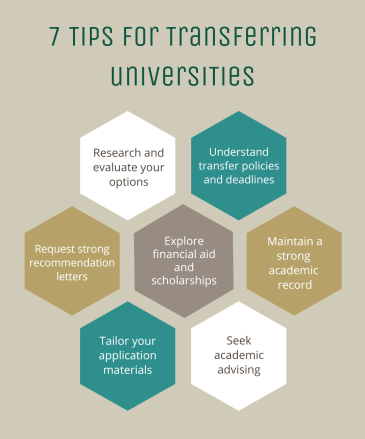
There are many students who end up attending multiple colleges in their higher education for a variety of reasons. Some go into college with the plan to eventually transfer, others might realize that the college they chose might not be the right fit for them, and decide to finish their degree at another college.
This also may be the case for students whose initial college application was denied in high school, or for those who want to complete some college credits at a community college.
According to the National Student Clearinghouse Research Center, approximately 2.1 million students transferred between postsecondary institutions in the 2020–21 academic year. Around 15% of undergraduate students in the U.S. transfer during their college years, so it’s important to know that you’re not alone and aren’t bound to the first college you attend.
Should I transfer universities?
Although transferring universities can be challenging and time-consuming, it can also be an immensely rewarding experience. If you’re thinking of switching colleges, identify and assess aspects of your current institution that you find fulfilling, as well as ones that cause dissatisfaction. Common reasons that students switch colleges include:
- Transferring from a community college
- Social isolation
- Financial situations
- Changing majors
- Returning to school to complete a degree
- Academic offerings
- Campus environment
- Surrounding city environment
Types of transfers
There are three possible directions for student mobility between institutions.
- Upward transfers: When two-year students transfer to a four-year institution.
- Lateral transfers: When students transfer from one four-year university to another or between two-year colleges.
- Reverse transfers: When four-year students transfer into two-year colleges.
When is it best to transfer colleges?
It’s recommended for students to transfer between school years or semesters, or at the beginning of their college career. This is because they would have completed courses that could be transferable, inevitably saving money because they won’t have to retake them. Students who change schools earlier on in their college career are also more likely to have taken general education (GE) courses, rather than ones tailored to their particular major.
Nevertheless, it is never too late to transfer colleges, and students decide to do so at various points in their college careers.
How long are college credits transferable?
Receiving colleges and universities will award transfer credits based on your previous college’s academic transcript. Keep in mind that some schools may not calculate your transfer credits until you’ve applied and been accepted to their institution. Although most college credits are transferable, a few factors determine whether they can be transferred:
- Final grade: Most colleges will only accept transfer credits if you earned a passing grade (typically a “C”) in a particular course.
- Accreditation: College-level courses taken at regionally accredited institutions are typically transferable. Accreditation is the certificate that US colleges and universities receive when they yield quality education.
- Course content: At receiving institutions, courses must be similar in depth and content to be considered for transfer credit.
However, keep in mind that some college credits may expire if you plan to take a break from college for a couple of years. For example, STEM (science, technology, engineering, and mathematics) credits are often valid for only 10 years due to advancements in the field. Graduate courses often have a seven-year life shelf for the same reason.
7 tips for transferring universities

1. Research and evaluate your options
Before initiating the transfer process, thoroughly research potential colleges and assess their suitability for your academic and personal goals. Consider factors such as:
- Program offerings
- Campus culture
- Cost
- Location
- Admission requirements
Taking advantage of college websites, informational sessions, admissions counselors, and tours can also help you gather more information about your school of interest. If you know someone who currently attends the school you plan on switching to, or even someone who transferred to that school, reach out to them to gain a personal perspective!
2. Understand transfer policies and deadlines
Each college has its own transfer policies and application deadlines. Familiarize yourself with these requirements to ensure a smooth transition. For example, if your prospective college uses the Common Application, you are given the option to create a “first year” or “transfer” account or change your account to transfer status. Some colleges also only accept these applications for specific quarters and semesters.
Some colleges may have specific GPA or credit hour requirements, prerequisite courses, or portfolio submissions. Stay organized and create a timeline to keep track of application submissions, financial aid deadlines, and housing deadlines.
______
Who are you called to be?
Pursue your purpose at PLNU.
______
3. Maintain a strong academic record
Admissions committees often give significant weight to your academic performance when considering transfer applications. Strive to maintain a strong GPA and complete required coursework. If you’ve had a challenging semester or faced personal difficulties during your academic venture, consider addressing these circumstances in your transfer application essay. Some colleges and universities also offer the opportunity for you to explain your academic performance in their application.
4. Seek academic advising
Reaching out to academic advisors, college counselors, mentors, and trusted friends or family members can help you gain clarity on your next steps. They may provide valuable insight and advice that you may have not considered, such as how switching schools can impact you financially, academically, and professionally. Discuss your goals, concerns, and aspirations with them to gain a well-rounded perspective on your decision.
Academic advisors and college counselors can help you fill out the correct forms, request college transcripts from your current or previous institution, and offer more logistical information about the transfer process.
5. Tailor your application materials
The application process for transfer students is different than it is for first-time applicants. For example, many schools do not require transfer students to submit their SAT or ACT scores, as they hone more into your academic performance.
With the help of academic advisors, college counselors, and your prospective university’s website, you will be able to see whether your application requires official or unofficial college transcripts. Other components of your application may include letters of recommendation and a personal statement, which explains your reasoning for switching schools.
6. Request strong recommendation letters
Letters of recommendation not only discuss your academic strengths and weaknesses, they also give the opportunity for external sources to share your goals and aspirations. Having a strong letter of recommendation in your application provides evidence of your involvement inside and outside of the classroom.
While first-year applicants are asked to submit letters of recommendation from teachers and guidance counselors, transfer students are encouraged to submit ones from professors and college advisors. Professors at your current institution who you’ve taken classes with can give insight into your diligence in the classroom, especially if you did well in their course. College advisors can also advocate for you via this typical application requirement.
However, you’re not limited to asking these two sources to write a letter of recommendation. You can also reach out to:
- Employers
- Mentors
- Coaches
- Club advisors
7. Explore financial aid and scholarships
If you plan to switch schools, make sure to alert your current institution’s financial aid office. They will help you make sure that your account is settled and that your college transcript is ready to be sent.
Additionally, submitting your Free Application for Federal Student Aid (FAFSA) to your prospective college will provide you with a new financial aid package. This is an important step because most financial aid will not automatically transfer with you. Your FAFSA may be able to determine your eligibility for state and/or school financial aid, loans, grants, and work-study funds. Check out the Federal Student Aid’s website to learn more.
Transfer to PLNU today
If you’re looking into switching schools, consider adding PLNU to your list. Regardless of where you are in your educational journey, this oceanfront university offers plenty of opportunities, including undergraduate, graduate, and accelerated undergraduate programs.